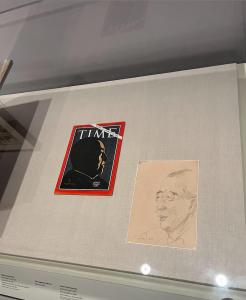
The Smithsonian’s Discovery of Saito Kiyoshi’s Early Original Historical Works Highlights the Artist’s Legacy

This private collection suggests that Saito was drawing high-ranking Japanese political figures well before his commission by Time magazine in 1967.
This discovery marks an important moment in the history of his art where later sōsaku hanga (creative printmaking) and the vast replication of his art through woodblock prints led to Saito's international recognition. In 1956, the State Department and the Asia Foundation sponsored him to travel and exhibit his work throughout the United States and Europe.
In 1955, baseball legend Mickey Mantle and the New York Yankees were invited to tour Japan, courtesy of the Mainichi Newspaper Company. During the visit, Japanese Prime Minister Ichirō Hatoyama welcomed the team while wearing a Yankees cap. Mantle celebrated his 24th birthday in Tokyo, and the Yankees played 16 games across the country, including one in Hiroshima—poignantly lending support to international diplomacy.
Prime Minister Kishi Nobusuke, the subject of one of Saito’s significant, scarce original portrait drawings of historical significance now owned by the Smithsonian,( a gift of the Ted M. Miller Kiyoshi Saito Historical Art Collection of Original Works) was donated to the museum in 2024 and will be on display through April 27, 2025 at the Smithsonian’s National Museum of Asian Art. This private collection suggests that Saito was drawing high ranking Japanese political figures well before his commission by Time magazine in 1967.
The art world eagerly awaits additional releases from this historical authentic collection. Many have suggested that these be placed in world class museums and never sold.
Prime Minister Kishi, like Saito, had visited the United States, where he addressed a joint session of Congress. During this visit, Kishi made a detour to Yankee Stadium, where he took in a doubleheader against the Chicago White Sox. Wearing a Yankees cap, Kishi threw out the ceremonial first pitch from his front-row seat, receiving a rousing ovation from the crowd. This visit also served as a diplomatic gesture.
The Prime Minister’s history was tumultuous but very pivotal post war. Before becoming Japan’s Prime Minister from 1957 to 1960, Kishi had served as Minister of Commerce and Vice Minister of Munitions under Prime Minister Hideki Tōjō's wartime cabinet. He co-signed the declaration of war against the United States on December 7, 1941, and was later imprisoned as a suspected war criminal. His tenure as Prime Minister was marked by the provocation of the massive Anpo Protests, which earned him the nickname "Monster of the Showa Era." Kishi was also the founder of the Satō–Kishi–Abe political dynasty, with his younger brother Eisaku Satō and his grandson Shinzo Abe both later serving as prime ministers.
As Prime Minister, Kishi sought to strengthen Japan’s relationship with the United States and ease tensions with Southeast and South Asian nations. He visited these regions in 1957 to promote reparations agreements and economic cooperation, and in 1959, he traveled to Western Europe and Latin America. Kishi returned to Washington, D.C., in January 1960 to sign a revised U.S.–Japan security treaty, aiming to restore independent diplomacy for Japan and put the relationship between the two nations on an equal footing.
During this period, Saito’s fame grew, and his work gained international recognition, particularly in the West. In the 1950s and 1960s, he played an instrumental role in bridging postwar relations between the United States and Japan. Saito’s involvement with U.S. cultural exchange programs, initiated by the State Department and organizations like the Asia Foundation, made him one of the first artists invited to the United States under these initiatives. His U.S. and European exhibitions further cemented his position as a renowned artist. Saito continued to refine his craft for the rest of his life, becoming one of the most influential and celebrated 20th-century artists.
Today, the Kiyoshi Saito Museum of Art in Japan and other world-class museums are dedicated to preserving and showcasing the works of the world-renowned woodblock artist. One in particular, the extraordinary Ringling Museum in Sarasota, Florida has been a major advocate of Saito’s works. Rhiannon paget, curator at the Ringling and author of the book Saito Kiyoshi Graphic Awakening is considered one of the foremost leading expert’s around the world on Saito’s works. The Ringling is also a recipient of a gift from this same original collection in year 2024.
Saito Kiyoshi’s contributions to art and history remain an indelible mark on the cultural landscape.
Staff Writer
Hey, Sandy! PR & Communications
+1 561-386-5262
email us here
Distribution channels: Business & Economy, Culture, Society & Lifestyle, Education, Travel & Tourism Industry, World & Regional
Legal Disclaimer:
EIN Presswire provides this news content "as is" without warranty of any kind. We do not accept any responsibility or liability for the accuracy, content, images, videos, licenses, completeness, legality, or reliability of the information contained in this article. If you have any complaints or copyright issues related to this article, kindly contact the author above.
Submit your press release

